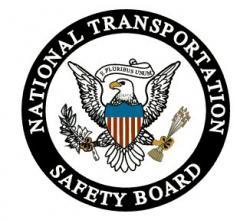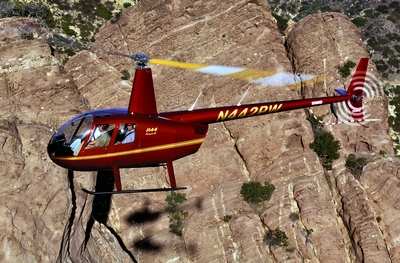 The preliminary NTSB
investigation (published below) into a tragic fatal R44 (file pix,
below) accident is turning up some worrisome details. The March
27th, 2007, accident near Jacksonville, FL, resulted in the deaths
of the two pilots aboard, Flight Instructor and Silver State
employee Tamara Williams, 38, of California, and student Justin
Ducan, 24, of Jacksonville, FL. What seems worrisome, according to
the NTSB report, is the "missing" attach hardware discussed in the
report and the fact that the accident occurred shortly after
maintenance. ANN is attempting to get a statement and some
background from Silver State Helicopters about the matter and will
keep you updated as the investigation proceeds...
The preliminary NTSB
investigation (published below) into a tragic fatal R44 (file pix,
below) accident is turning up some worrisome details. The March
27th, 2007, accident near Jacksonville, FL, resulted in the deaths
of the two pilots aboard, Flight Instructor and Silver State
employee Tamara Williams, 38, of California, and student Justin
Ducan, 24, of Jacksonville, FL. What seems worrisome, according to
the NTSB report, is the "missing" attach hardware discussed in the
report and the fact that the accident occurred shortly after
maintenance. ANN is attempting to get a statement and some
background from Silver State Helicopters about the matter and will
keep you updated as the investigation proceeds...
NTSB Identification: DEN07FA079
14 CFR Part 91: General Aviation
Accident occurred Tuesday, March 27, 2007 in Ponte Verde Bch,
FL
Aircraft: Robinson R44 II, registration: N744SH
Injuries: 2 Fatal.
This is preliminary information, subject to change, and may
contain errors. Any errors in this report will be corrected when
the final report has been completed.
 On March 27, 2007, approximately
1030 eastern daylight time, a Robinson R44 II single-engine
helicopter, was destroyed when it impacted terrain following a loss
of control during cruise flight near Ponte Verde Beach, Florida.
The flight instructor and student pilot were fatally injured. The
helicopter was registered to and operated by Silver State
Helicopters, LLC, North Las Vegas, Nevada. Day visual
meteorological conditions prevailed and a company visual flight
rules flight plan was filed for the Title 14 Code of Federal
Regulations Part 91 instructional flight. The local flight departed
the Craig Municipal Airport (CRG), Jacksonville, Florida,
approximately 1010.
On March 27, 2007, approximately
1030 eastern daylight time, a Robinson R44 II single-engine
helicopter, was destroyed when it impacted terrain following a loss
of control during cruise flight near Ponte Verde Beach, Florida.
The flight instructor and student pilot were fatally injured. The
helicopter was registered to and operated by Silver State
Helicopters, LLC, North Las Vegas, Nevada. Day visual
meteorological conditions prevailed and a company visual flight
rules flight plan was filed for the Title 14 Code of Federal
Regulations Part 91 instructional flight. The local flight departed
the Craig Municipal Airport (CRG), Jacksonville, Florida,
approximately 1010.
According to Silver State personnel, the local flight was
scheduled for a time block between the hours of 0900 and 1100. The
instructional flight was originally scheduled to be conducted in
the R22; however, due to a scheduling conflict, the R22 was not
available. Due to the conflict, the Silver State local management
then allowed the instructor and student to conduct an orientation
and familiarization flight in the R44 helicopter. The route of
flight was scheduled for a east departure from CRG, south along the
Atlantic Ocean coastline to St. Augustine, then back to CRG.
Several witnesses observed the helicopter approximately 200-500
feet above ground level (agl) in cruise flight along the coastline
on a south heading. One witness, a former pilot and mechanic,
reported he observed the helicopter in straight and level flight,
then heard a change in "rotor noise, followed by a bang/pop/twang
sound." The helicopter then "snap-rolled" to the left and descended
into the terrain in a nose low attitude. The helicopter impacted
the sand terrain, bounced, and came to rest near the low tide water
line. A post-impact fire ensued and extinguished itself a short
time thereafter.

The main wreckage came to rest on the beach at 30 degrees 13.54
minutes north latitude and 81 degrees 22.32 minutes west longitude.
The initial impact point, consistent with the fuselage, was a
4-foot crater in the sand terrain located at the high tide
waterline. The helicopter wreckage was distributed along a measured
magnetic heading of approximately 160 degrees from the initial
impact point. The main wreckage came to rest approximately 100 feet
from the initial impact point. The main wreckage consisted of the
fuselage, main rotor assembly, tailboom and tail rotor. Several
fragmented pieces of the fuselage and skid tubes were located
between the initial impact and main wreckage. The engine was
separated from the airframe and came to rest adjacent to the main
wreckage. Due to tide change, the wreckage was recovered under the
supervision of a Federal Aviation Administration (FAA) inspector to
a facility at CRG.
 Examination of the
helicopter by the NTSB investigator-in-charge, FAA inspectors, and
representatives from the airframe and engine manufacturers revealed
that the fuselage sustained thermal damage and impact damage to the
right side. The forward section of the tailboom, lower mast, and
engine cowling sustained thermal damage. Examination of the flight
control system revealed that the right forward servo to swashplate
push/pull tube fitting was disconnected and the attach hardware
(bolt, lock nut, two washers, pal nut) was missing. The left
forward servo to swashplate push/pull fitting was connected;
however, the lock nut was found partially engaged on the bolt
threads and the torque was "finger tight"; no pal nut was noted.
The aft servo and push/pull tube fitting was secured with the
appropriate hardware.
Examination of the
helicopter by the NTSB investigator-in-charge, FAA inspectors, and
representatives from the airframe and engine manufacturers revealed
that the fuselage sustained thermal damage and impact damage to the
right side. The forward section of the tailboom, lower mast, and
engine cowling sustained thermal damage. Examination of the flight
control system revealed that the right forward servo to swashplate
push/pull tube fitting was disconnected and the attach hardware
(bolt, lock nut, two washers, pal nut) was missing. The left
forward servo to swashplate push/pull fitting was connected;
however, the lock nut was found partially engaged on the bolt
threads and the torque was "finger tight"; no pal nut was noted.
The aft servo and push/pull tube fitting was secured with the
appropriate hardware.
The swashplate push/pull tubes are connected to the swashplate
assembly and the upper linkage of the servos. The bottom linkage of
the servos is connected to a bellcrank/fork assembly which then
connect to the cyclic and collective thru a series of push/pull
tubes and bellcranks. The three servos support the main rotor
swashplate and hydraulically boost the main rotor flight controls
to eliminate cyclic and collective feedback forces.
On March 26, 2007, the aircraft was returned to service after a
100/300 hour inspection was performed and mast fairing ribs were
removed and replaced. During the mast fairing rib replacement, the
swashplate push/pull tubes were removed. Prior to the aircraft
being returned to service, a 0.5 hour maintenance test flight was
performed by the mechanic and a company pilot. The accident flight
was the first flight performed after the maintenance test
flight.
 NTSB Final Report: Cozy Cub
NTSB Final Report: Cozy Cub ANN FAQ: Contributing To Aero-TV
ANN FAQ: Contributing To Aero-TV Classic Aero-TV: Seated On The Edge Of Forever -- A PPC's Bird's Eye View
Classic Aero-TV: Seated On The Edge Of Forever -- A PPC's Bird's Eye View ANN's Daily Aero-Linx (04.29.25)
ANN's Daily Aero-Linx (04.29.25) ANN's Daily Aero-Term (04.29.25): Execute Missed Approach
ANN's Daily Aero-Term (04.29.25): Execute Missed Approach






